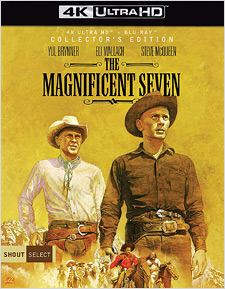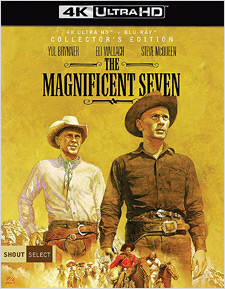Magnificent Seven, The (1960) (4K UHD Review)

Director
John SturgesRelease Date(s)
1960 (February 21, 2023)Studio(s)
The Mirisch Company/United Artists (Shout! Factory)- Film/Program Grade: B+
- Video Grade: A-
- Audio Grade: B
- Extras Grade: B
Review
[Editor’s Note: The film comments are by Adam Jahnke, from his review of the 2001 DVD Special Edition. The 4K disc A/V and extras comments are by Bill Hunt.]
In the long line of Hollywood remakes of foreign films, perhaps no Americanization was more natural or inevitable than The Magnificent Seven. Based on Akira Kurosawa’s Seven Samurai, itself heavily influenced by the Westerns of John Ford, director John Sturges had little trouble transplanting the Japanese story to a village in Mexico. Surprisingly, The Magnificent Seven has become a classic in its own right. The combination of a can’t-lose story, a cast comprised largely of actors on the threshold of becoming major stars, and an unforgettable, instantly recognizable musical theme, have allowed the movie to continue winning fans more than sixty years after its debut.
The story remains the same as in Kurosawa’s film; a small farming village is terrorized by a group of bandits (led here by Eli Wallach). Without the means to protect themselves, they hire a diverse group of gunslingers. They include Chris Adams, the man in black (Yul Brynner, an Oscar winner for The King and I and the marquee name at the time of the movie’s release), the cool as ice Vin Tanner (Steve McQueen, then a TV star on Wanted Dead or Alive), money-hungry Harry Luck (Brad Dexter… trivia buffs will want to file that name away to win bar bets as poor Mr. Dexter is the one people always forget), the Mexican-Irish Bernardo O’Reilly (Charles Bronson), the knife-wielding Britt (James Coburn), Lee, the man of mystery (Robert Vaughn a couple years before becoming Napoleon Solo on The Man from U.N.C.L.E.), and Chico, a young tag-along eager to prove himself (Horst Buchholz, stepping none too agilely into the role played by Toshiro Mifune in Seven Samurai). The seven arrive in town, train the villagers to defend themselves, and face off against Wallach and his band of cutthroats.
The Magnificent Seven is nowhere near as good as Seven Samurai, but that’s all right. Very few movies are. On its own terms, The Magnificent Seven is a most entertaining Western. Brynner is certainly good as the ostensible leader of the pack, but it’s his co-stars that end up stealing the show. McQueen, Coburn, Bronson, and Vaughn make this movie the fun ride it is. In a way, that’s what works against the movie too. The best Westerns revolve around a strong magnetic center, whether it’s John Wayne or Clint Eastwood or James Stewart. Brynner isn’t quite up to the task of anchoring this movie, so it’s no trouble at all for McQueen to steal focus. And while Seven Samurai took well over three hours to make every member of its group a sharp, well-defined character, The Magnificent Seven doesn’t have that luxury.
The Magnificent Seven was photographed by cinematographer Charles Lang (A Farewell to Arms, Gunfight at the O.K. Corral, How the West Was Won) on 35 mm Eastman Color film using Panavision cameras with anamorphic lenses, and it was finished photochemically at the 2.39:1 “scope” aspect ratio for theaters. For its first-ever release on Ultra HD, Shout! Factory has utilized a pre-existing 4K scan of the original camera negative but completed an all-new digital restoration and high dynamic range color grade (both Dolby Vision and HDR10 are available). Save for optically-printed titles and transitions, as well as the usual anamorphic softness on the edges of the frame, overall image detail is remarkable—crisp and readily apparent in faces, textiles, brick, and stone work (the church and its courtyard being a prime example), as well as in the rocky hills above the Mexican village. The anamorphic lenses also tend to enhance the sense of depth in the image. Blacks are strong yet retain a good amount of detail, while the highlights are naturally bright but also restrained. Colors are accurate, occasionally even vibrant (McQueen’s blue eyes are piercing indeed), though the film has a bleached appearance that’s by design, meant enhance the arid landscapes. Photochemical grain is medium, and occasionally strong in transitions, but always remains organic looking. While it falls short of reference quality, this is a pleasing 4K image that represents this film well.
Audio on the 4K disc is included in English 2.0 mono in DTS-HD Master Audio format, a track that preserves the original theatrical sound experience. Also included are English 2.0 stereo and 5.1 surround mixes in DTS-HD MA. These are perfectly fine, and extend the soundstage a bit around the listener, but they require a bump in volume to really please sonically. All in all, the mono mix the clear winner, with a fuller tonal quality, and a greater front-and-center presence. Dialogue is clean and readily discernible, sound effects and Foley are well blended, and Elmer Bernstein’s rousing and memorable score is presented in excellent fidelity. All of these tracks are largely free of analog pops, hiss, and other age-related issues. Optional English SDH subtitles are available for those who might need them.
Shout! Factory’s 4K release is a 2-disc set that includes the film in Ultra HD and also remastered Blu-ray. Both discs include the following special features:
- Audio Commentary by James Coburn, Eli Wallach, Walter Mirisch, and Robert Relyea
- Audio Commentary by Sir Christopher Frayling
To this, the Blu-ray adds the following:
- Guns for Hire: The Making of The Magnificent Seven (SD – 46:55)
- Elmer Bernstein and The Magnificent Seven (SD – 14:49)
- Sir Christopher Frayling on The Magnificent Seven (SD – 20:22)
- The Linen Book: Lost Images from The Magnificent Seven (SD – 14:49)
- Original Theatrical Trailers (HD – 2 trailers – 5:52 in all)
- Still Gallery (HD – 4:09)
The commentary with Coburn, Wallach, producer Walter Mirisch, and assistant director Robert Relyea carries over from the 2001 Special Edition DVD release. Each of these veteran participants has great stories to tell and they’re told well here, making for an entertaining listening experience. (Coburn was probably the last person alive who could get away with calling someone “groovy.”) The Frayling commentary is also from a previous DVD release, in this case MGM and Sony’s 2006 Collector’s Edition. As always, the historian delivers a constant and interesting stream of trivia and production anecdotes. In terms of the video-based material, Guns for Hire also carries over from the first DVD release and while there’s a bit of repetition from the commentary, it’s a good look at the production of the film, including vintage interviews with Brynner and others, as well as newer comments by fans like Chazz Palminteri and John Carpenter. The rest of the featurettes and the gallery are from the 2006 DVD, examining the film’s iconic score, its origins and influence, and its “lost” linen book of production photography. There’s also a video still gallery and a pair of theatrical trailers for the film, and these are presented in full HD. No Digital Copy code is included, but you do get a cardboard slipcover (with the first pressing of the disc) to go with the regular Amaray case. It features handsome-looking original artwork.
Though a pale imitation of Kurosawa’s original film, John Sturges’ The Magnificent Seven has become a beloved American classic and was highly influential in its own right. It’s also, arguably, one of Hollywood’s last great Westerns, as the genre was soon after dominated by Italian films from the likes of Leone and Corbucci, not to mention a host of popular TV series. Shout! Factory’s 4K release presents the film in best-ever image quality and carries over all of the previous special features, so fans will certainly wish to give it a look.
- Adam Jahnke (with Bill Hunt)
(You can follow Adam on social media on Facebook as well as his Jahnke's Electric Theater Facebook page. You can also read his Disney Plus-Or-Minus on Substack.)
(You can follow Bill on social media at these links: Twitter and Facebook)

